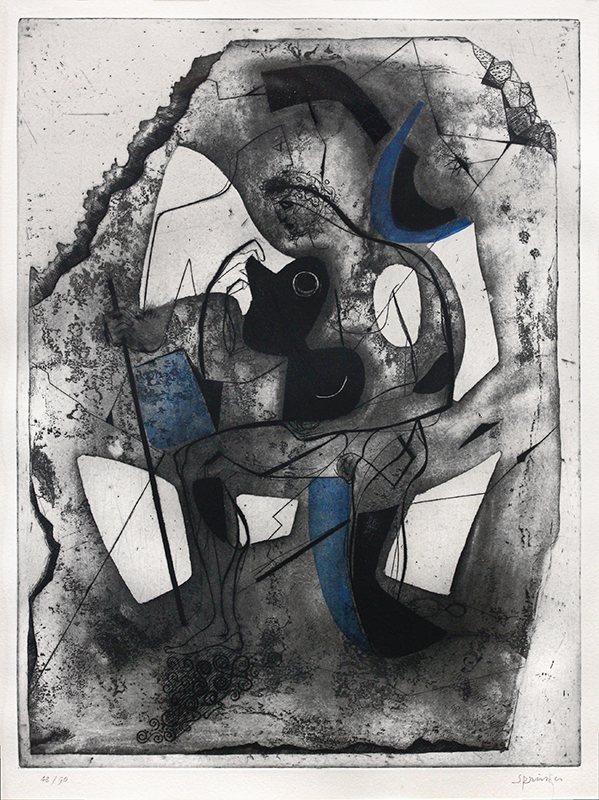Prométhée IV is a mixed technique color intaglio first created in 1947 by the French artist Ferdinand Springer. This impression was published in 1962 by Edition de Beauclair, Frankfurt and is accompanied by a letterpress poem by Georgos Seferis titled Wir die wir auszogen (We Who Took Off). Prométhée IV is pencil signed and editioned 43/90. It was printed by Willy Steinert on ivory laid paper watermarked Auvergne a la main produced by Richard de Bas papermill. The reference is Höfchen 35 and the platemark measures 15-9/16 x 11-5/8 inches.
The subject of Prométhée IV is the Greek god Prometheus, who angered Zeus by stealing fire from Mt. Olympus and giving it to humans, thereby changing the world. Prometheus was tied to a rock where an eagle ate his liver daily, it regenerated at night because he was immortal. He was finally freed by Hercules.
Ferdinand Springer, painter and printmaker, was born to a German father and a Swiss mother in Berlin on October 1, 1907. After graduating from high school in Potsdam, he studied art history at the University of Zurich. He began painting in 1927 and visited Milan where he met the Italian painters Giorgio Morandi and Carlo Carrà.
Springer moved to Paris in 1928 where he studied with Roger Bissière at the Académie Ranson. In 1932, he learned intaglio techniques at Atelier 17 in Paris and, in 1937, he traveled to New York where he exhibited at the Julian Levy Gallery. During this time he met Alexander Calder and Salvatore Dali. Springer’s wife was Jewish and his father wanted him to sign papers denouncing her to the Nazi government which he refused to do. After moving to Grasse in southern France in 1939, Springer was interned by the Nazis, along with Max Ernst, Hans Bellmer and Otto Wols at the Camp des Milles near Aix-en-Provence.
After his release in 1940, Springer returned to Grasse and started the “Grasse Group” with Hans Arp, Sonia Delaunay, Alberto Magnelli and others, and produced his first abstract works. With the escalation of the war Springer escaped to Switzerland in 1942 but was not allowed to exhibit his work. He returned to Grasse in 1945 to discover that of most his work was lost.
In 1946, Springer created engravings for
Paul Valery’s Eupalinos VI, and in
1952 he relocated to Paris and returned to painting in 1955. He resettled in
Grasse in 1960 and became a pioneer in the revival of
printmaking, along with Johnny Friedlander, Pierre Courtin, and Henri-Georges
Adam. He continued to work and to exhibit throughout Europe and the United
States, and in the early 1990s began focusing on painting large canvases.
A retrospective of Springer’s oil paintings, watercolors, drawings, engravings, tapestries, and sculptures, created between 1929 and 1967, was presented at the Kunstverein Heidelberg in 1967. That same year, André Malraux, as Government Minister of France, awarded Springer the medal Chevalier des Arts et des Lettres.
Springer's work is represented in the
collections of the Kunstmuseum, Basel; the Kunstmuseum, Bern, Switzerland; the Kunsthalle
Bremen, Germany; the Brooklyn Museum, New York; the Fogg Art Museum, Cambridge,
Massachusetts; the Cincinnati Art Museum, Ohio; the Yale University Art Gallery,
New Haven, Connecticut; the Museum of Modern Art, New York; the Musée National
d'Art Moderne, Paris; the Bibliothèque nationale de France, Paris; the Musée
des Beaux-Arts, Rouen; the Fine Arts Museums of San Francisco, California; the Library of Congress, Washington, D.C.;
Ferdinand Springer died on 31 December 1998
in Grasse, France.



